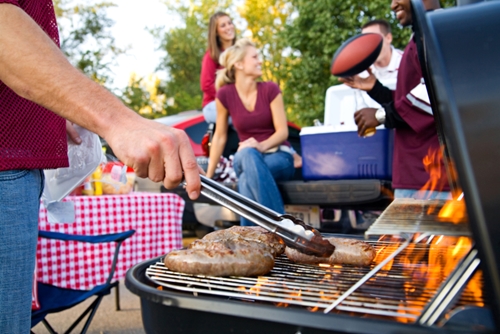5 Tips For Better Grilling
With the weather warming up for spring, you’ll soon be pulling the cover off your grill. Nothing beats preparing food outside on a warm day with family and friends. But this year, when you throw the burgers and hot dogs on the griddle, you can make them better than ever. Here are five cooking tips that will bring your grilling game to the next level:
1. Choose your charcoal
Of course, you can get perfectly tasty results using a gas grill, but purists will always insist on charcoal. Not all cooking fuel is the same, though. To get the best results, you should learn the different types and choose what best suits your needs.
As Bon Appetit explained, the varieties of charcoal are mainly split between lumps and briquettes. Lump hardwood charcoal is clean-burning, contributing a pleasantly smoky flavor and reaching higher temperatures than briquettes. The latter, however, is more consistent in how it burns and the size and shape of the pieces.
Binchotan is an exceptional form of white hardwood charcoal that is too expensive for everyday grilling. However, if you set out to make eel or chicken on a hibachi, you’ll be able to tell the difference. You’ll also get a distinctive flavor if you use instant charcoal briquettes, which are presoaked in lighter fluid, but it probably won’t be the taste you’re after.
2. Use a charcoal chimney
A charcoal chimney is a simple metal cylinder, but it can make a huge difference in how your barbecued foods turn out. You can skip the lighter fluid while safely and efficiently starting a flame. As a result, your creations will taste of smoke, not chemicals.
The Grilling Spot stated that you should begin by opening the chimney’s air vents and placing a few pages of newsprint in the bottom. Add coals and set the chimney safely on the charcoal grate before lighting up the newspaper. After a couple minutes the smoke should die down, and in 20 minutes or so the charcoal will be ready for cooking.
3. Arrange the coals
Wear protective gloves when handling hot coals, and don’t just dump them onto the grate and start grilling. Instead, give some thought to how you will deliver the right kind of heat for the food you’re making.
According to Serious Eats, there are several different kinds of fires that you might employ.
- In a direct fire, you evenly spread out the coals to cook several items at once for a large group of people.
- The two-zone direct fire is split between one area with the majority of the briquettes or lumps and a second with about half the quantity. This way, you can sear a piece of meat and then heat it slowly over a lower temperature.
- For a larger roast or whole chicken, use a two-zone indirect fire. In this set-up, you restrict all the coals to one side and allow the indirect heat to slowly cook the meat, rotating it occasionally.
- Heat a smaller roast with a three-zone split fire, in which you line up coals on either side and leave the center clear. This has the added advantage that you can catch drippings with an aluminum pan.
4. Check the heat
Some grills have built-in thermometers. If yours doesn’t, you’ll have to test the heat by using your hand. Real Simple explained that you can do so by placing your palm three inches or so above the grill. Count the seconds before you must pull your hand away.
- You can last up to nine seconds for a low heat of less than 300 degrees Fahrenheit.
- Four or five seconds suggests a medium heat between 350 and 400 degrees Fahrenheit.
- If you can only handle one or two seconds, it is likely a high heat of up to 500 degrees Fahrenheit.
5. Keep your grill clean
Regularly cleaning your grill will prevent rust, carbon and ash from building up. Your food will taste better and cook more easily if you perform proper maintenance.
The Kitchn recommended using a grill brush on both grates. Of course, removing food remnants from the grill grate is easiest when you have already preheated. Don’t forget to toss out any debris in the bottom of the grill and ash catcher.
With these pointers, you’ll be well on your way to making barbecue favorites that will please all your guests.








Wow, I didn’t know that there were different types of fires you could use when grilling food. It seems to me that different foods can be grilled better depending on the fire that is used to cook them. I wonder if this is taken into account when crafting grilling recipes for different kinds of meat.